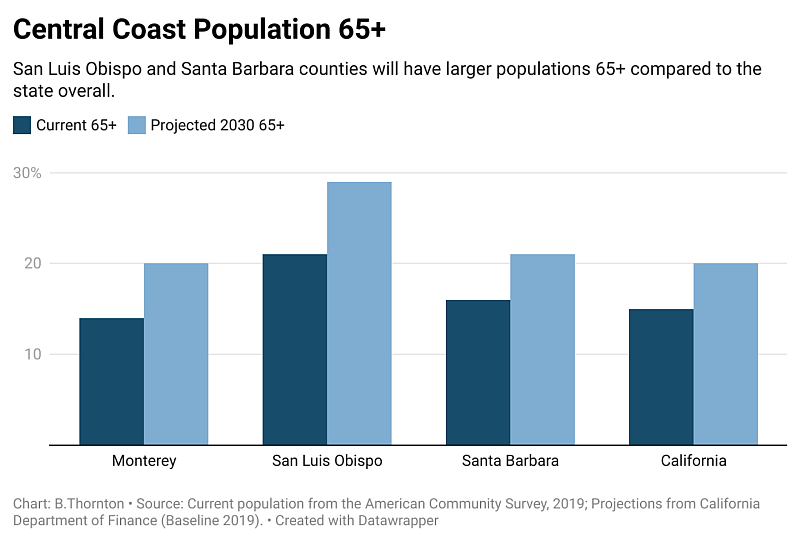The impact of an aging population on Central Coast health care and health care workers
This is the first in a series of stories for KCBX reported as a project for the USC Annenberg Center for Health Journalism 2021 Data Fellowship.
Other stories in this story include:
Part 2: The impact of an aging population: nurse shortages on the Central Coast
Part 3: The impact of an aging population: a growing need for memory care as the Central Coast ages

The U.S. population is aging. The baby boom generation will be 65-and-over by 2030.
Simonkr / E+
In his 2019 State of the State address, California Governor Gavin Newsom spoke about aging baby boomers, one of the largest generations in US history born between 1946 and 1964.
“The Golden State is getting grayer. We need to get ready for this major demographic challenge headed our way. For the first time in our history, older Californians will outnumber young children,” said Governor Newsom in his February 2019 State of the State Address.
According to the Public Policy Institute of California (PPIC), about one in five Californians will be over the age of 65 by the year 2030.
On the Central Coast, in Santa Barbara and San Luis Obispo counties, the number is projected to be even higher than 20%.
Professor Peter Rupert, director of the UC Santa Barbara Economic Forecast Project, said the Central Coast population over 65 is bigger than other parts of the state.
“It’s not a large number difference compared to California as a whole, but certainly it is larger,” he said.
Rupert keeps a close eye on the local economy, including the health care sector.
“As we age, we need more health care, that’s been well documented and it’s hard to argue with that, and as we know, our population has been aging given the retiring of the baby boomers, and we’re starting to see a lot more need for health care,” he said.
According to Rupert, the impact of an aging population on health care and health care workers is pretty straightforward.
“What that means for the health care system is that we need more health care employees, we need more facilities, there’s no doubt about that as people demand more care,” he said.
Joanne Spetz, PhD., director of the Philip R. Lee Institute for Health Policy at UC San Francisco, analyzes data on the nursing workforce in California. Her 2018 report, Regional Forecasts of the Registered Nurse Workforce in California, projects nursing shortages for the Central Coast region.
“The overall forecasted number of nurses is expected to stay pretty flat in the Central Coast, but the projected demand for nurses is expected to grow because of the aging of the population,” Spetz said.
Her research was conducted before the coronavirus pandemic, and she said its full impact on the workforce won’t be known for a while, however, anecdotal reports suggest that some nurses are leaving the field earlier than expected. But, according to Spetz, the Central Coast region attracted fewer nurses even before the pandemic.
“One of the biggest factors is educational availability. Where are the nursing schools and how many graduates are they producing in each region of California? The Central Coast does not have very many nursing education programs available,” she said.
Beth Thornton /
The two large public universities in the area, UC Santa Barbara and Cal Poly San Luis Obispo, do not have nursing schools. The area benefits from community college programs and partnerships with state colleges nearby, but there are limited opportunities for 4-year or advanced RN degrees.
Spetz said places with multiple nursing schools and large teaching hospitals, for example, the Bay Area, parts of Los Angeles, and Orange County, have more nurses. She expects nurse shortages to vary by region as new graduates consider cost of living and career opportunities when deciding where to work.
“When you’re looking at a very high cost of living area like the Central Coast, that can dissuade people from returning there for their first jobs after graduation,” she said.
Based on Spetz’s forecasts, which account for population growth, population aging, and anticipated changes in the numbers of new registered nurse (RN) graduates, the Central Coast region could have approximately 25% fewer RNs than needed in 2035 unless opportunities for education and employment grow to meet the demand.
Corrine Ratcliffe, RN, is associate director of nursing for Central Coast Community Health Centers (CHC).
CHC provides primary care and services to thousands of patients in medically underserved communities, with 31 locations from Nipomo to Cambria in northern Santa Barbara and San Luis Obispo counties.
“We serve the medically underserved, so this would be our patients that have no insurance, our farming communities, our agricultural workers, our MediCal patients...we take care of everybody,” Ratcliffe said.
She said currently she does not have trouble filling positions, and her organization regularly assesses staff salaries to ensure that nurses and medical assistants earn a competitive wage.
“This is something that we’re always looking at, so we can keep our staff,” Ratcliffe said.
Looking ahead, she said the Central Coast does have a few obstacles to overcome as the population ages, and it is not just about nurses. She cites the need for more specialists for referrals, especially in fields like cardiology and ophthalmology, and more beds in local nursing homes.
Rupert, with the UCSB Economic Forecast Project, agrees there are challenges, but he is confident the Central Coast can meet the growing demand by expanding resources, including telehealth, and by offering nurses and nurse practitioners more incentives to work in the region.
“What we’re going to need to see in the health care industry is rising wages, we're going to need to see better startup packages, more flexibility, maybe some shorter hours, all of those things combined are going to help attract workers into that industry,” he said.
This is the first in a series of stories for KCBX reported as a project for the USC Annenberg Center for Health Journalism 2021 Data Fellowship.
[This article was originally published by KCBX.]

